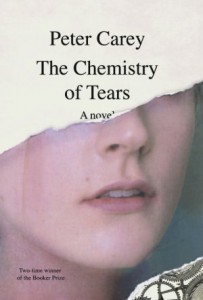Peter Carey’s twelfth novel, The Chemistry of Tears, explores reanimation, resurrection, and the impossibility of raising the dead. It begins at the moment Catherine Gehrig, a clockwork specialist at the fictional Swinburne Museum in London, discovers that her lover of thirteen years has died. Her public anguish poses a problem as the deceased — Matthew Tindall, Head Curator of Metals — was married, their long affair conducted in secret. Thus, Head Curator of Horology Eric Croft, revealing his knowledge of the relationship, whisks Catherine to the museum’s annex where he tasks her with reassembling a 19th-century automaton, guided only by the manuscripts left behind by the machine’s architect, Henry Brandling. There, Eric hopes, she may grieve as she loved — in private.
At first Catherine is resistant to the project, but as the days pass she gradually trains her attention on the disassembled machine. Through a series of eleven hand-written manuscripts, she becomes more and more acquainted with the inventor Henry Brandling, a British aristocrat who in 1854 traveled to rural Germany in search of a clockmaker to build a mechanical duck to entertain his convalescent child.
Henry’s manuscripts alternate chapters with Catherine’s first-person narrative. They are partly epistolary (dispatches to the ailing boy) and partly technical notes, detailing the operations of the duck, which in theory would walk, flap its wings, ingest food and even excrete it. The letters document Henry’s travels deep into the Black Forest as he finds himself racing to build the machine before his son dies, while his guide slowly reveals grander and stranger plans for Henry’s contrivance. Catherine reads the journals while nursing a bottle of vodka in her lonely flat, wondering to herself: “Was he, without knowing it, building some mad monument to grief, a kind of clockwork Taj Mahal? Or was that me?” The machine appears to Catherine to be terminally flawed, its chassis too small to incorporate its innards, its proportions fatally miscalculated, its artifice theoretically impossible. And yet she scours Henry’s journals each night and returns to her workshop in the isolated annex each day.
Henry, as Catherine observes, is not an easy companion. He’s dull, paranoid, arrogant, naïve, and easily confused. Unfortunately, Catherine’s not very sympathetic either, even in her vulnerability — she’s dour, delicate, and has a habit of making cruel, off-the-cuff remarks to well-meaning co-workers. As readers we find ourselves pitying her situation but not always enjoying her company, particularly as her recollections of her affair with Matthew tend toward the cloyingly precious (she gratingly refers to him as her “secret darling”).
That the protagonists are exasperating is no small weakness, but nonetheless Carey has produced some remarkable writing in The Chemistry of Tears. The passages that stand out are Carey’s descriptions of place, moments when Catherine and Henry recede to reveal the odd splendor of the Swinburne and the Black Forest, respectively. The Swinburne is at once whimsical and convincing, and while Catherine herself is difficult to love, her environment is abundant with sumptuously detailed antiquities — Islamic water clocks, ancient Chinese timepieces, and of course the impossible mechanical duck. It’s a pleasure to wander the Byzantine corridors of the museum’s substratum with her, even as she weeps drunkenly over her horologist’s toolkit. Carey leads Henry into a world even more fanciful, the Black Forest envisioned as a sinister hinterland peopled with hostile peasants, obstinate innkeepers, idiot savants, demented clockmakers and ethereal wunderkinds. This imagination is derived from the Brothers Grimm, who are referenced throughout, and indeed readers’ enjoyment of these passages (as well as the novel more generally) is sure to correspond to their appetite for tales involving alchemy, mystery and gloom.
This post may contain affiliate links.









